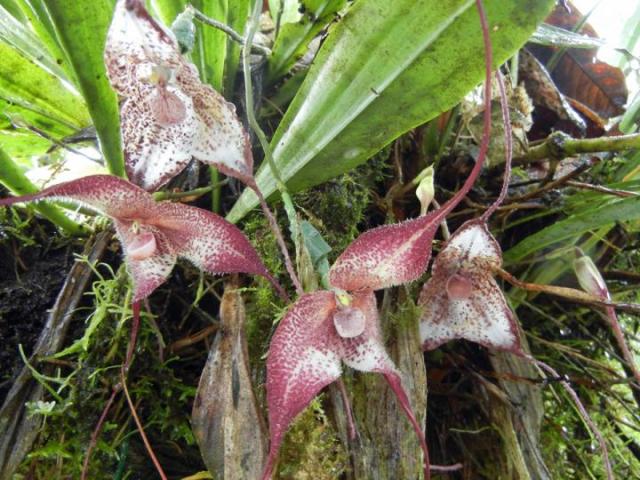Feb 24 2016
University of Oregon (UO) researchers have discovered the secret behind the mimicry used by Dracula orchids to attract flies and guarantee their survival, using a 3D printer to spoof the flies.
 Real orchid, left, is shown along with 3-D copies of orchids that were combined with parts of real flowers for field experiments in Ecuador. Researchers studied what plant odors and coloration were most successful in luring pollinating flies. Credit:Photo by Aleah Davis
Real orchid, left, is shown along with 3-D copies of orchids that were combined with parts of real flowers for field experiments in Ecuador. Researchers studied what plant odors and coloration were most successful in luring pollinating flies. Credit:Photo by Aleah Davis
The study was conducted in Ecuador, and according to Barbara "Bitty" Roy, a professor of biology at UO, it is highly promising for use in evolutionary biology as the method applied in the experiment can be readily adapted to various studies of other plant-pollinator systems. She also added that the information obtained from these kinds of research should aid in enhancing the efforts taken to conserve endangered habitats.
Mimicry is one of the best examples of natural selection that we have. How mimicry evolves is a big question in evolutionary biology. In this case, there are about 150 species of these orchids. How are they pollinated? What sorts of connections are there? It's a case where these orchids plug into an entire endangered system. This work was done in the last unlogged watershed in western Ecuador, where cloud forests are disappearing at an alarming rate.
Barbara Roy, Professor of Biology, UO
Dracula orchids can be found in Central America and the northwest regions of the Andes Mountains in South America. The orchid is labeled as Dracula, which literally means "little dragon", due to the face-like mark in the flowers.
Dracula orchids look and smell like mushrooms We wanted to understand what it is about the flowers that is attractive to these mushroom-visiting flies.
Tobias Policha, Adjunct Instructor and Plant Scientist, UO's Institute of Ecology and Evolution
The scientists chose to study 22 orchids in detail to establish where specific scents are generated in the flowers, and which scents actually attract pollinators. In this case, the pollinator was 11 species of fruit flies that flourish among wild mushrooms growing in the vicinity of the orchids.
Using a 3D printer, the researchers created odor-free, silicone copies of orchids to test their theory in the forest. The 3D copies resembled the real orchids in both shape and size, and allowed the researchers to apply different color patterns and various scent extracts on them. As part of the elaborate experiments, the team also utilized chimeras, 3D-based copies comprising both real and artificial parts. This allowed them to decipher which parts were attractive and which parts were not. Flies began to be attracted to the artificial plants as if they were real.
Melinda Barnadas, co-author and co-owner of Magpie Studio, which creates scientific artwork for museums, built the 3D versions. Barnadas is also a visual artist at the University of California, San Diego, and worked with the team researching the orchids in Ecuador.
The research was able to pinpoint the mushroom-like labellum in the orchid as the major part of the orchids' mimicry. The labellum is attached to the narrow reproductive column of the plant.
What the orchid wants the fly to do when it arrives is to crawl into the column, whereupon the orchid sticks a pollinium onto the fly so that the fly can't possibly get it off. The fly then goes to another orchid, which then pulls it off.
Barbara Roy, Professor of Biology, UO
The orchid's pollen is contained in a pollinium, which is a sticky package that looks like a saddlebag. The flies spent about an hour within the reproductive column of the plant. Just over 80 species of drosophilid flies were able to fit into the column.
The paper’s other co-authors were Aleah Davis, a UO undergraduate student in the Robert D. Clark Honors College during the research; Bryn T.M. Dentinger, a former UO postdoctoral researcher; and Robert A. Raguso of Cornell University.
Davis has now finished a master's degree in public administration at Portland State University, while Dentinger is currently in the UK, with the Jodrell Laboratory of the Royal Botanic Gardens, Kew, and the Institute of Biological, Environmental and Rural Sciences at Aberystwyth University.
The research was supported by the National Science Foundation and the National Geographic Society, including a $573,000 grant under the American Recovery and Reinvestment Act in 2009. The paper was published online ahead of print in the New Phytologist journal.